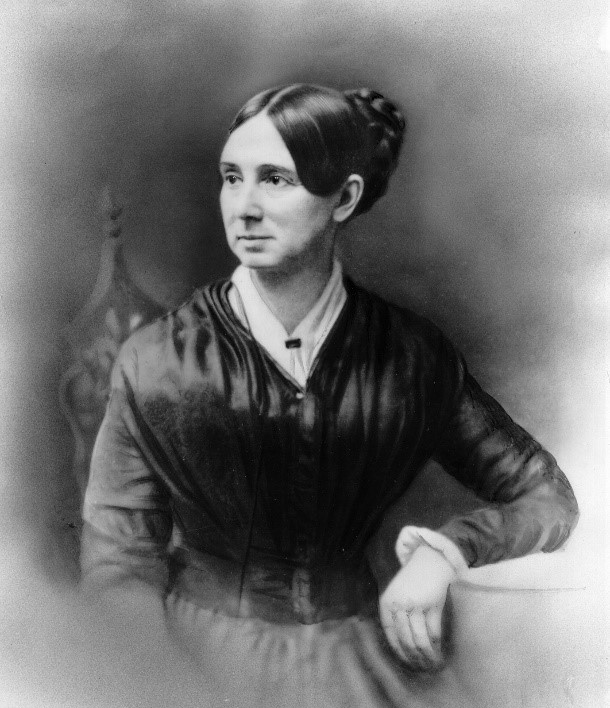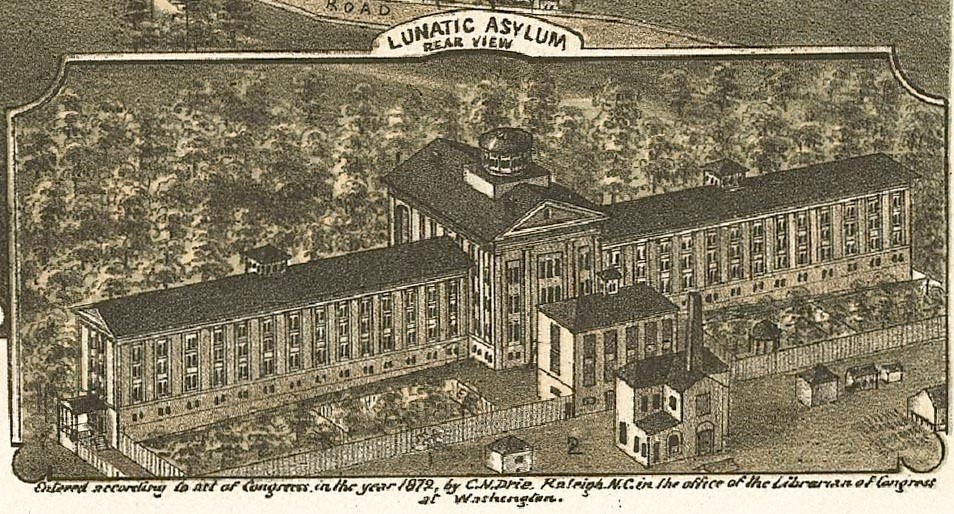Dorothea Dix
Contributors
- Rebecca Garlick
- Allie Jarvis
- Emma Mounteer
- Sadie Price
- Alexis Smith
Editors/Reviewers
- Sean N. Bennett, RN, MSN - Associate Professor - Utah Valley University - Orem, Utah

The Life of Dorothea Dix Discovered
Early Life
Dorothea Lynde Dix was born on April 4, 1802, to Joseph Dix and Mary Bigelow Dix on a small frontier settlement in Hampden, Maine. Her childhood was difficult and lonely. After Dorothea, two more siblings were born. They were two boys – Joseph and Charles. Her father inherited a farm from Dorothea's grandfather, but he chose to be an itinerant Methodist minister and was often away from home. Joseph made a meager income selling copies of his sermons. Dorothea had the responsibility of assembling and sewing the pamphlets together (Dorothea Dix, biography.com, 2014).
Dorothea’s mother was bed ridden after the birth of her second brother, and she remained a semi-invalid who suffered from what sounds like debilitating depression (History, 2017). As the oldest of three children, Dorothea became responsible for most of the farm and household work. Dorothea vowed she would have no childhood because it was already her job to care for her two younger brothers. When Dorothea was twelve years old she moved to Boston, Massachusetts with her two brothers, Joseph and Charles, to live with their paternal grandmother at the Dix Mansion (Bumb).
Though her father suffered from alcoholism, he taught Dorothea about reading and writing at a very young age. This encouraged her love for reading and learning and she also taught her younger brothers how to read. That learning experience is where she gained a desire to be a teacher (Bumb). In 1814, when Dorothea's wealthy grandmother became her primary caregiver, she demanded that Dorothea act like a wealthy girl. Her grandmother thought that dance and sewing lessons would help to make this happen. However, Dorothea did not have any interest or intention in participating in such activities. One time Dorothea’s grandmother caught Dorothea giving food as well as new clothes to beggar children at their front gate. Dorothea was immediately punished for doing so. After Dorothea refused to follow her grandmother’s wishes to become and associate herself as a rich girl, Dorothea was sent to live with her aunt when she was fourteen, so her aunt could turn her into a “lady” based on her grandmother’s requests (Bumb). Her aunt, actually her great aunt, Mrs. Duncan, lived in Worchester, Massachusetts. Dorothea resided there for four years where she met lots of wealthy, distant family members.
The Proposal and Dix Mansion
While at her Aunt’s, Dorothea often attended parties. There she met her second cousin, Edward Bangs, who was an attorney. She told him of her wish to be a school teacher, and he suggested that she start what was called “a little dame school” (Bumb). At that time, girls could not attend public school, but they could be taught by other women in private. In 1816, at the age of fourteen, Dorothea started her small school with twenty girls ages six, seven, and eight. She ran the school for three years (Dorothea Dix, biography.com, 2014).
In 1819, Edward wound up proposing to Dorothea. Dorothea was only 18, and he was 13 years older. She became frightened and closed the school and returned back to Boston (Bumb). When Dorothea returned back to Boston, she wrote a letter to her grandmother saying that she wanted to start a school for girls at the mansion. She wanted to open it for poor girls and a have a separate class for wealthy girls. Her grandmother agreed. Dorothea became the founder of the Dix Mansion, a school for girls and also a charity that poor girls attended for free. Edward followed her there, and she accepted his proposal but would not commit to a date. She feared marriage because of the bad relationship her parents had with fighting, drinking, and deserting their children. Dorothea eventually returned her engagement ring and officially refused Edward’s marriage proposal in 1821 because she wanted to devote herself to teaching. Her father died that same year from alcoholism (Bumb).
Love for Writing
Dorothea had faced some hard obstacles up to this point in her life, but she pressed through those difficulties and really began to pursue her dreams. Her high education in mathematics and fluent speech of Italian, Greek, and Latin became useful in influencing others. She created her own form of curriculum and did her best to work on establishing a school. In 1821, following her rejection to Edward, Dorothea Dix actually established an official elementary school at her grandmother’s house. There she eventually published a small book of facts for schoolteachers and it became very popular among them. This book, Conversations on Common Things, was published in 1824 (Dorothea Dix, biography.com, 2014). Guide to Knowledge: With Questions was reprinted 60 times and was directed at young women interested in the teaching profession (Parry, 2006). This book was about her belief that women should be educated just the same as men. She influenced many women and became known as an activist in her community, showing other women that women truly are capable of doing great things.
Dix published several other books as well, even ones that emphasized religious poetry or fictional texts that integrated a moral lesson. Dix’s publications and the social circles that formed because of it allowed her to learn from some of the most influential thinkers during her time. She met and talked with Ralph Waldo Emerson and worked as a governess for William Ellery Channing, who was the “Father of Unitarianism” (Parry, 2006).
Mental Breakdown
In 1831, Dix started a secondary school in her own home. After five years, the physical demands of running the school and caring for so many children took a toll on her health. She became sick – suffering from fatigue, often developing a cold. She suffered from depression as well and began to focus on her own death. During this period of her life, she began to have a mental breakdown which forced her to close her school (History, 2017). She traveled to England and resided with a man named William Rathbone. He helped Dorothea for more than a year to recover as she agreed to have a time of rest (Parry, 2006). Her declining health became the reason why her teaching career ended; however, this started a new chapter in Dorothea's life.
The Prison System
In 1841, Dorothea began to teach Sunday school which led her to East Cambridge Jail where she had the opportunity to teach prisoners. While she was teaching at the jail, she discovered the prisoners were being treated very poorly especially those that were mentally ill. The prison provided the prisoners with absolutely no heat! Upon discovering this, Dorothea felt compelled to do something, so she took action (History, 2017). She went to court and filed a petition to allow the prisoners to have heat while staying in the prisons. She also petitioned for improvements so that the prisoners would be treated better (Dorothea Dix, biography.com, 2014). This was a huge step taken by Dorothea because during this time period women were not allowed to vote, nor were they allowed to hold office. A man had to read the testimony of the women to the legislature to get them to adhere to the petitions on behalf of the women.
In 1843, Dorothea went to the courts in hope of bringing justice for the mentally ill. She wanted them to stop being treated badly and to be able to get the help they needed in proper institutes. In 1845, Dix wrote a book called “Remarks on Prisons and Prison Discipline in the United States”; she hoped that this book would bring discussions within the government to implement the education of prisoners, as well as separating the different types of offenders within the prison (Reddi, 2017).
Hospitals
In the following years to come, Dix helped many cities and countries outside of the United States to see the issues she fought so hard for. There were 32 new mental hospitals built from her efforts which she made in the prison systems. The hospitals were built in states such as New Jersey, Pennsylvania, Indiana, Illinois, Kentucky, Missouri, Tennessee, Mississippi, Louisiana, North Carolina, and Maryland (Dorothea Dix, biography.com, 2014). She also helped

with establishing a government hospital, which is now known as the St. Elizabeth's in Washington, D.C. From the years of 1843 – 1880, the original 13 hospitals grew to 123 throughout the states, Europe, and Japan all thanks to Dorothea Dix's due diligence (Reddi, 2017).
The Civil War
In 1856, Dorothea Dix returned back to the United States. The Civil War broke out in 1861, when Dix was 59 years old. She immediately became inspired to aid in the war effort. On April 19, 1961, a Massachusetts regiment was attacked by a mob in Maryland and Dix immediately took action by taking a train to Baltimore, but she realized that hospitals were already providing aid. She then continued on to Washington D.C. where she offered her services as a nurse at the War Department. It was there that she was named the Superintendent of Union Army Nurses on June 10, 1961, even though she had never had formal medical training or experience (History, 2017). She was appointed to organize and outfit the Union Army hospitals. Dix was the first woman to serve in such a high capacity in a federal role. Dix’s main responsibility was to manage the flow of bandages and clothing as the war went on, and her impressive administrative skills were the base of this task (History, 2017). Her other responsibilities included setting up field hospitals and field stations, recruiting nurses, setting up training programs, and managing supplies. Along with her task of organizing women volunteers and the 3,000 plus women who served as Union Army Nurses, she enforced a dress code of modest black or brown skirts. Other guidelines Dorothea set as superintendent for the nurses in her care were that they must be between the ages of 35 and 50, be plain-looking, and never wear any ornaments or jewelry (Ducksters, 2017). Although Dix was not in perfect health, she did not miss one day of work. She was very focused and efficient with her tasks, but many people found her rigid, and lacking the social skills that were necessary to navigate the military’s bureaucracy. After two years with this responsibility, Dix was finally sent home.

European and American Travels
When she returned home, she continued her work as a social reformer, working and fighting for the mentally ill’s health. She traveled a lot, especially in Europe, and continued to write and lobby for her causes in behalf of the mentally ill. In 1867, Dorothea Dix went and visited many European countries. She continued her work in these foreign places as she helped Europe better design care for their insane. In 1870, Dorothea Dix contracted malaria (Dorothea Dix, biography.com, 2014). This illness caused her extensive traveling to cease; however, it did not stop her from writing or traveling around North America. Dix continued to travel around the United States to help others gain a better understanding of the mentally ill. She wrote of her experiences even into her old age (History, 2017).
Retirement
When Dorothea Dix retired in 1881 at the age of 79, she no longer discussed her previous work (Nursing Theory, 2016). After the war ended she dedicated most of her time helping others. She was full of empathy and kindness – humbling herself as a servant would. She related to the people she dedicated her time to helping. As quoted by Dorothea Dix herself, “If I am cold, they are cold; if I am weary, they are distressed; if I am alone, they are abandoned” (Reddi, 2017). There is a lot that can be said about having an honorable character. It takes courage to stand up and fight for those who cannot fight for themselves. And that is exactly what Dorothea Dix spent her life doing.
Dorothea Dix’s Passing
In 1881, a hospital in Trenton, New Jersey was built and dedicated due to Dorothea’s life efforts. Dedicating this hospital to the life and service of Dorothea was a direct contradiction to what she would have done. It was the first hospital built, dedicated to Dorothea, and opened due to Dorothea's life-long work.

When her health began to fail, Dorothea Dix checked herself into the state hospital of Trenton, New Jersey (Dorothea Dix, biography.com, 2014). She stayed in this hospital for six years as her health continued to decline. This is where, on July 17, 1887, Dorothea Lynde Dix passed away at the rightful age of eighty-five due to what her physician called ossification of the arterial membrane. She was buried in the Mount Auburn Cemetery, which is located in Cambridge, Massachusetts, with a small and simple funeral service (Reddi, 2017).
Accomplishments
Dorothea Dix was known for the way she revolutionized mental institutions. Her lifelong work is not widespread; however, those who know of her respect her work and efforts. It is said that she did not include her name on many of her published works and that she refused to have her hospitals named after her (Bumb). Most of Dorothea's unpublished works and letters are at Harvard University while other letters are at the Menninger Foundation and the Kansas Historical Society (Nursing Theory, 2016). It was not until the end of her life that a hospital was dedicated in her name – the Trenton, New Jersey hospital. It is believed she wanted her accomplishments to rest quietly when she died. Her modesty for her work helps others see how she was as a person as she did not want praise for her many accomplishments. Dorothea Dix was a dedicated nurse and leader, and in 1979, Dorothea Dix was entered into the National Women’s Hall of Fame (Maclean, 2008). She never did get married, but for what she accomplished, it all worked out well as she was able to use her time to help many.
References
- This is an item in a list
- Bumb, J. Dorothea Dix. Retrieved from http://faculty.webster.edu/woolflm/dorotheadix.html
- Crompton, Samuel Willard, 100 Americans Who Shaped American History, 1999, pgs. 38-39
- DesRochers, A. (2012, March 29). Dorothea Dix: Mental Health Reformer and Civil War Nurse. Retrieved July 26, 2017, from https://siarchives.si.edu/blog/dorothea-dix-mental-health-reformer-and-civil-war-nurse
- Dorothea Dix. (2014, July 24). Dorothea Dix. Retrieved May 17, 2017 from https://www.biography.com/people/dorothea-dix-9275710
- Ducksters. (2017). Dorothea Dix. Retrieved from http://www.ducksters.com/history/civil_war/dorothea_dix.php
- History. (2017). Dorothea Lynde Dix. Retrieved from http://www.history.com/topics/womens-history/dorothea-lynde-dix#
- MacLean, M. (2008). Dorothea Dix. Retrieved from http://www.civilwarwomenblog.com/dorothea-dix/
- Nursing Theory. (2016) Dorothea Dix, Mental Health Advocate. Retrieved from http://www.nursing-theory.org/famous-nurses/Dorothea-Dix.php
- Parry, M. S. (2006, April). Dorothea Dix (1802–1887). Retrieved May 17, 2017, from https://www.ncbi.nlm.nih.gov/pmc/articles/PMC1470530/
- Reddi, V. (2017). Dorothea Lynde Dix (1802-1887) Retrieved from http://www.truthaboutnursing.org/press/pioneers/dix.html
- The Editors of Encyclopedia Britannica. (2017, January 20). Dorothea Dix. Retrieved May 17, 2017, from https://www.britannica.com/biography/Dorothea-Dix
- Toler, Pamela D. Ph.D., Heroines of Mercy Street, 2016, pgs. 9-3